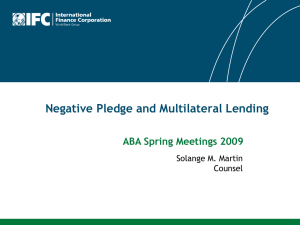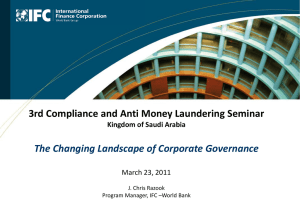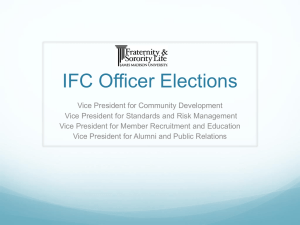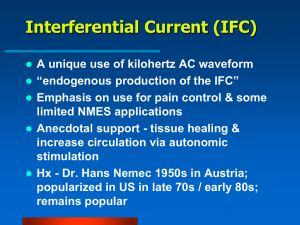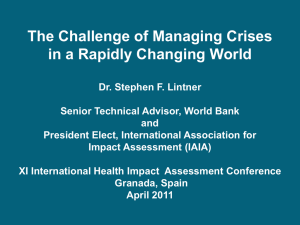Review of IFC`s Role in China`s Financial Sector Transformation
advertisement
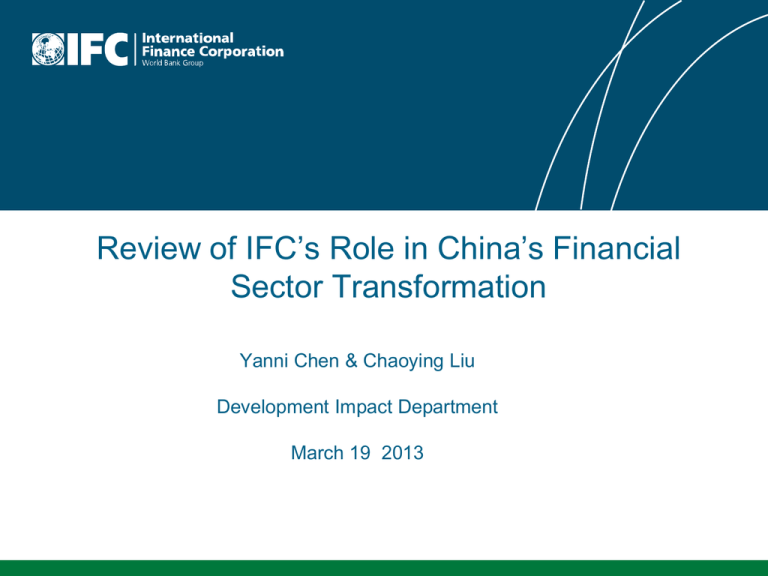
Review of IFC’s Role in China’s Financial Sector Transformation Yanni Chen & Chaoying Liu Development Impact Department March 19 2013 Agenda 1. Context and Methodology 2. Key findings – Advisory Services 3. Key findings – Local Currency Financing 4. Key findings – Investment Operations 5. Conclusions and Lessons Learned •2 Agenda 1. 2. 3. 4. 5. Context and Methodology Key findings – Advisory Services Key findings – Capital market Key findings – Investment Conclusion and Lessons Learned •3 Context IFC’s engagement in China’s financial sector China started financial sector reform in 1990s. Successful financial sector reform would have huge impact on the country’s economic development and poverty reduction •1992 – IFC office in China •1995 - IFC's Operations and Strategy in China •2002 – IFC AS facility in Chengdu, Western region of China •2003 - World Bank and IFC’s country strategy for China •2007- IFC’s financial sector strategy for China Operations •First investment to Bank of Shanghai in 1999, 50 Investments in FIs, valued at $1b •AS facility in Western of China - 46 Advisory services projects , valued at $50m •3 Bond issuances, valued at $300m •4 Objective of the review •To understand if and in what ways IFC has contributed to the financial sector reform in China •To identify lessons learned for future strategy and operations •First such review in IFC covering IS, AS and treasury operations - focusing on IFC’s contribution •5 Scope of the review •Advisory Services •Policy work relating to financial infrastructure (secured transactions and credit reporting system), Microfinance, Housing finance, Green credit, and sector-wide capacity building •Investment Operations •Commercial bank investments and Microfinance •Local Currency Financing •Renminbi denominated bond, Swaps facility •6 Data sources •Primary • Interview: unstructured interviews with over 30 key stakeholders, investment clients, government agencies, and IFC staff • Site visit and in-depth interviews with beneficiaries of IFC’s clients: SME banking, microfinance, RMBdenominated bonds • Secondary • Project documents • Available evaluations and reviews • Media materials •7 Analytic Framework IFC’s intervention Results chain Storyline •Secured Transactions •Commercial banks •Credit Reporting •MFs •Green Credit •Energy Efficiency •Capital markets •Sector-wide capacity building Sector •How IFC contributed to creating a favorable environment? Institution Beneficiary •How IFC contributed to building institution capacity? •How IFC intervention helped improve business access to finance? •8 Agenda 1. Context and Methodology 2. Key findings – Advisory Services − − − − Secured transactions reform Credit reporting system Green credit policy Sector-wide capacity building 3. Key findings – Capital market 4. Key findings – Investment 5. Conclusions and Lessons Learned •9 Supported Secured Transactions Reform Context • 2005/2006 SME survey – 70% SMEs no access to finance due to lack of acceptable collaterals • Lenders’ concern – no proper legal framework, no single registry • $9 trillion in dead capitals locked in SME sector Intervention A 5 year collective effort of WB, IFC and Chinese government, costing $1.6m • Legal framework – passed the property laws in 2007 • Infrastructure – a centralized registry • Capacity building – regulators, bankers and public •10 Supported Secured Transactions Reform Results • Enabled a strong growth of movables financing − Loans secured by movable assets comprise 40% of the total loans in China during 2008-10 vs 4% in 2005 − $3.5 trillion cumulative value of accounts receivable financing as of 2012 • Increased SME lending portfolio - 7 large commercial banks reported 45% in 2008-10 vs. 20% in 06-08 period • Removed barrier for SME access to finance – 68,575 SME received financing secured by accounts receivable over $1 trillion • 60% of the surveyed SMEs believe that without their current access to accounts receivable financing, their business development would be severely impacted •11 Advised the establishment of Credit Reporting System Context • Before 2003, China had no consumer credit database Intervention A 7 year effort, costing $400,000 • Regulation – PBOC Regulation on Consumer Credit Information Database; CBRC - administrative rules requiring all FIs to report credit information • Infrastructure - Consumer credit information database • International best practice, capacity building •12 Advised the establishment of Credit Reporting System Results •The largest credit information database in the world built in 2006. By the end of 2010, the database covered more than 777 million individuals •2007 China was recognized as one of the top 10 reformers in Doing Business •By the end of 2010, the cumulative number of inquiry for 812 million consumer database •Credit reporting system helps enterprises and individuals build up their credit history, and facilitate loans to the lower-end of the market. From 2006 to 2009, the number of enterprises with bank loans increased by 50%; the number of individuals with bank loans increased by 145%. •13 Promoting Green Credit Policy Intervention • Started in 2007, Provided policy advice to and PBOC and CBRC on formation of Green Credit Policy, eg., Guidelines on Credit Granting for Energy Conservation and Emissions Reduction; Provided training and study tours. Results • IFC’s PS and EP are now well established within key Chinese banks • Green Credit Guidelines launched in 2012 which specified how to integrate energy-efficient financing practices into lending • Demonstration effect The IFC-China Green Credit partnership model has been expanded to Vietnam, the Philippines, Malaysia and Indonesia • South-South knowledge exchanges • Too early to tell the impact on the ground •14 Sector-wide Capacity Building Institutions China Banking Association China Banking Regulatory Commission People's Bank of China Shanghai International Banking & Finance Institute National Development and Reform Commission Total Training Topic Bank Certification and CCB (City Commercial Banks) Capacity 1. Reviewing drafts of leasing law; 2. Low and Moderate Income Housing, Mortgage Lending, Mortgage Insurance, etc. 1. NDTL(Non-Deposit-Taking Lending Institutions) Regulation, Microfinance Development and Mobile Banking 2. Best Practice in Credit Registry, Credit Reporing, Legistration on Credit Information Services in China 3. Legislation and Practice of Secured Transactions Law in China 4. International Best Practices in Secured Transactions, Rural Collateral System Reform; 5. Mobile Banking Market 1. "Credit Analysis and Commercial Lending" Workbook 2. General capacity building topcis for banks 1. International Experience on Promotion of SME 2. Drafting the report of CSR (Corporate Social Responsibilities) in China 3. Drafting the report of external financing regime in China Number of workshop Number of s/training participants Number of women participants 33 2654 356 43 2868 290 91 11352 1463 154 25 1228 192 18256 2109 •15 Agenda 1. Methodology 2. Key findings – Advisory Services 3. Key findings – Local currency financing – – Renminbi denominated bond Renminbi swap facility 4. Key findings – Investment 5. Conclusions and Lessons learned •16 Local currency financing Intervention Renminbi denominated bond •In 2005 IFC and ADB became the first foreign issuer of bonds on the Chinese domestic market through yuan-denominated “Panda Bonds.” •From 2005-2011, in total IFC issued 3 Bonds at valued at $300m or RMB 2.15b. Renminbi swap facility •In 2011 IFC signed a swap legal agreement with 2 banks and became the first multilateral institution authorized to conduct transactions with Chinese financial institutions in the domestic local-currency swap market •In 2012 Board approved a lend of $50 million to Jiangsu Financial Leasing to be funded through the Swap Facility •17 Local currency financing Results •Opened the Chinese bond market to international financial institutions •Improved and strengthen regulatory framework •Introduced international good practice •Supported high quality domestic companies with long-term local currency financing, with low interest rate •Job creation, research development, GHG emission reduction •Evaluation of impact on the local capital markets is underway •18 Agenda 1. 2. 3. 4. Context and Methodology Key findings – Advisory Services Key findings – Local currency financing Key findings – Investment - Commercial Banking - Microfinance 5. Conclusions and Lessons Learned •19 Commercial Banking •20 Context in the 1990’s • Financial sector dominated by banks • Banking sector dominated by the “Big Four” state-owned banks • High NPLs in banking sector: 25-40% • Regulation prohibits foreign investment in banks • No foreign banks were interested • Bank loans most important source to firms • No access to finance for SMEs: 1% bank loans to private sector •21 What Did IFC Do? - Investments (Excluding CHUEE facilities) Category IFC First Board Approval Year 1999 2001 2006 2001 2004 2004 2005 2006 2007 2008 2009 Total IFC Investment Amount ($) Bank of Shanghai Bank of Nanjing Bank of Nanjing Minsheng Bank Industrial Bank Xi'an Commercial Bank Bank of Beijing Hangzhou URCB Tianjin Binhai RCB UCB China Deyang CCB* Total City commercial Bank City commercial Bank City commercial Bank Joint stock commercial bank Joint stock commercial bank City commercial Bank City commercial Bank Rural commercial bank Rural commercial bank Foreign invested commercial bank City commercial Bank Data source: Data notes: IFC project documents *: pending Chinese government approval **: IFC nominated an independent director ***: IEG XPSR 2006 rating. DOTS rating not available. IFC Equity Share IFC Latest DOTS Appointed Development Director? Outcome Rating 88,500,000 5% increased to 7% Yes Successful 26,600,000 15% Yes Successful 47,600,000 Loan Nominated 27,000,000 0.92% increased to 1.1% ** Satisfactory*** 52,200,000 4% Yes Highly successful 3,250,000 2.5% Yes Mostly Successful 59,000,000 5% Yes Highly successful 27,630,000 5% Yes Successful 63,930,000 10% Yes Successful 45,000,000 Loan 31,000,000 15% 471,710,000 •22 What Did IFC Do? - Advisory Category Bank of Shanghai Bank of Nanjing Minsheng Bank Industrial Bank Xi'an Commercial Bank Bank of Beijing Hangzhou URCB Tianjin Binhai RCB Total City commercial Bank City commercial Bank Joint stock commercial bank Joint stock commercial bank City commercial Bank City commercial Bank Rural commercial bank Rural commercial bank Data source: Data notes: IFC project documents IFC Advisory AS AS Services Strategic Risk Amount ($) Planning Mgmt 1,000,000 487,500 700,000 700,000 1,200,000 4,087,500 Yes Yes Yes Yes Yes 5 Yes Yes Yes Yes Yes 5 AS AS AS - Int'l AS - IFC Stress Credit Corporate Accounting SME Test in Training Governance Standards Banking 2005 Yes Yes Yes Yes 4 Yes Yes Yes Yes Yes Yes Yes 7 Yes Yes Yes Yes Yes Yes Yes Yes Yes Yes Yes Yes Yes 5 5 Yes 4 This table was compiled using information from various IFC projects documents. It is possible that not all IFC advisory services to these banks have been documented in the materials reviewed for this study. + Sector level seminars and training programs Presentations to the banking regulator •23 Results • Demonstration effect Year IFC Invested or nearest available 920 73 656 309 Bank of Shanghai Year IFC Invested or nearest available 2011 24 76 282 Bank of Nanjing 361 Minsheng Bank 956 851 341 25 41 102 Industrial Xi'an Bank Commercial Bank 233354 Bank of Beijing 6,335 5,807 3,235 2,934 1,391 267 166909 Bank of Shanghai Year IFC Invested or nearest available 2007 Bank of Nanjing Minsheng Bank 2007 2011 25,597 2,409 Non-Performing Loans • Corporate governance • Strategic focus on SMEs 2007 28,061 2,229 • Business strategy and risk management Profits (RMB Million) Assets (RMB Billion) 8,946 8,586 3,348 1,107 1,686 112 1,101 Industrial Xi'an Bank Commercial Bank Return on Equity 2011 Year IFC Invested or nearest available 2007 2011 22.2% 34.0% 19.9% 18.0% 3.0% 2.6% 2.5% 2.41% 0.98% 1.79% 0.78% 1.15% 0.38% Bank of Shanghai Bank of Nanjing Bank of Beijing 4.96% 0.98% Industrial Xi'an Bank Commercial Bank 11.1% 5.9% 24.0% 15.9% 18.2% 16.0% 14.6% 13.6% Hangzhou URCB 22.8% 23.0% 19.3% 10.5% 6.5% 5.8% 2.06% 0.91% 0.79% 0.53% 1.3% Bank of Beijing 25.3% 24.7% Bank of Shanghai Bank of Nanjing Minsheng Bank Industrial Xi'an Bank Commercial Bank Bank of Beijing •24 Structure of China’s Financial Sector •25 Results - cont’d IFC contribution limited in a few of the banks due to: • • • • Small stake Less developed region Heavy government influence Management not receptive to international investors’ influence •26 Microfinance •27 Context in late 2000’s • ~ 300 NGO type programs, unsustainable • Regulatory environment, “formative” – no clarity on which agency regulates and licenses MFIs • Lack of professionally managed MFIs • Government experimenting different models, including VTBs • Legal status of MCCs only established in 2008 •28 What Has IFC Done? - Institutional Level Existing Investments Zhong An Credit MicroCred China Renshou VTB * Bayan VTB CFPA MF Shenzhen VTB Beichuan VTB * XinJiang MCC Fullerton Credits** Total Data source: Data notes: Institution Type Type MFI MFI VTB VTB MFI VTB VTB MFI MFI Existing Greenfield Greenfield Greenfield Transformation Greenfield Greenfield Greenfield Existing IFC Board IFC IFC Share IFC IFC Advisory Approval Investment of Total Investment Services Year Amount ($) Equity Instrument Amount ($) 2007 2007 2009 2009 2010 2010 2010 2011 2012 2,500,000 1,149,425 1,464,504 1,746,586 5,770,484 2,930,017 1,731,288 1,050,000 50,000,000 68,342,305 15% 20% 14% 10% 10% 10% - C Loan Equity Equity Equity Equity Equity Equity Equity A Loan Latest DOTS Development Outcome Rating 710,000 Successful 1,000,000 Mostly Unsuccessful 784,000 835,000 1,000,000 Successful - Too Early To Tell 1,000,000 2,050,000 7,379,000 IFC project documents *: pending Chinese government approval **: includes Fullerton Credit Sichuan, Fullerton Credit Chongqing, and Fullerton Credit Hubei. •29 Results • Most investments too early to tell yet • Success story: CFPA Microfinance Co.: - NGO transformation - Strong business performance - Clear focus on poverty reduction - Opportunities for women • Challenges faced: - Delayed government approval - Slow ramp-up - Funding constraints, partly due to regulatory issues •30 Agenda 1. Methodology 2. Key findings – Advisory Services 3. Key findings – Local currency financing 4. Key findings – Investment 5. Conclusions and Lessons learned •31 Conclusion of the Review • China’s financial sector experienced transformational changes in the past 20 years. • Many factors were at play, and an important force behind the change was the Chinese government. • IFC has made significant positive contributions to this progress by playing roles of - a catalyst - a strategic investor - and a technical advisor, facilitator, and knowledge broker. •32 Lessons Learned • Taking calculated strategic risk pays off • Remaining relevant to government’s priorities and having strong client commitment help move forward agenda • A programmatic approach and long-term view is crucial for delivering systemic impact • Combining local knowledge and international expertise is critical • Co-investing and collaborating closely with strategic investors enhances success chances •33 Lessons Learned – cont’d • Being supply-driven leads to less success • Better resource allocation within IFC would help increase impact • Timing and mode of entering less-developed region needs to be better planned out • Small stakes restrict influence •34 Feedbacks from Clients “Not just to Bank of Shanghai, but to the entire banking sector in China, IFC brought in international best practices in bank management.” - Han Wenliang, Director of Board Supervisory Office, Bank of Shanghai “There would not be today’s Bank of Nanjing without IFC. IFC was a pioneer in pushing through China’s financial sector reform.” - Zhang Weinian, Head of Executive Office, Bank of Nanjing “IFC was a pioneer. Since IFC’s investment in 2005, Bank of Beijing has seen improvement in all aspects. IFC has played an irreplaceable role.” - Yang Shujian, Board Secretary, Bank of Beijing “The most important contribution of IFC was to bring in the concepts of corporate governance and balancing shareholder interests.” - Tang Bin, Director of Board Secretariat, Industrial Bank “IFC contributed to the transformation of the bank from a rural cooperative to a rural commercial bank.” - Long Yun, Chief, Office of Board of Directors, United Rural Commercial Bank •35 Feedbacks from Clients They also told us that IFC: • Is bureaucratic, slow, and inefficient • Uses cookie-cutter approach, lacks customization and flexibility • Is big on ideas and concepts, weaker on implementation and technical support • Lacks continuity in relationship management sometimes • Was HQ-centric back then: meetings at 12am Asia time; no decision-making power in region •36 Looking Forward Challenges facing China and IFC’s Strategic Focuses • • • • Climate change Access to finance Balanced growth between urban and rural Integration in the world economy •37 •Lessons Learned: M&E Recommendations Thank You! •38
